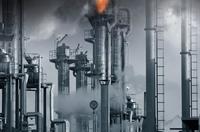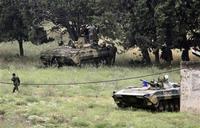-
Off-shore barges considered for destroying Syria’s chemical weapons
After failing to find a country willing to allow its territory to be used for disposing of Syria’s chemical weapons, the United States is exploring other options. Two options being seriously considered involve the destruction of Syria’s chemical weapons off shore, rather than on land. Both proposals call for removing the chemical weapons from Syria and placing them on a large barge at sea, where they would be dissolved or incinerated.
-
-
Destroying Syria's chemical weapons in the midst of war
Close to 1,400 tons of chemical weapons are stored at twenty-three locations scattered throughout Syria. To destroy this stockpile, officials will need multiple strategies. The most dangerous are the munitions filled with “live” chemical agents, such as mustard gas, sarin, and VX. Dealing with these weapons will require bringing specialized equipment into the war-torn country.
-
-
Sunlight-activated nanogrid breaks down pollutants in water
Oil spills do untold damage to the environment — to the waters they pollute and to marine and other wildlife. The Deepwater Horizon spill in the Gulf of Mexico in 2010, for example, the largest accidental marine oil spill in the history of the petroleum industry, flowed unabated for three months. Typically, such oil spills are extraordinarily difficult to clean up. Soon, however, the process may become infinitely easier and ecologically friendly, the result of a new invention — “nanogrid” — a large net consisting of metal grids made of a copper tungsten oxide, that, when activated by sunlight, can break down oil from a spill, leaving only biodegradable compounds behind.
-
-
Preventing a Bhopal-like catastrophe in New Jersey
New Jersey is home to ninety facilities which produce and store large quantities of highly toxic chemicals. A superstorm or terrorist attack could doom millions of people around southern New Jersey and eastern Pennsylvania to a Bhopal, 1984-like fate if either of these facilities and their storage tanks were affected.Typically, in the aftermath of major disasters, a blue ribbon panel is created to review preventative measures that could have been taken before the disaster. Security experts say that there is no need to wait for a post-disaster blue ribbon panel investigation to know what sensible safety measures should be implemented now.
-
-
Budget impasse halts enforcement of chemical plants safety standards

Security experts say that short of a direct nuclear attack on a U.S. city, the most dangerous, mass-casualty catastrophe the United States faces is a terrorist attack on, or an accident in, a chemical facility which would release toxic clouds over neighboring cities and towns. The federal government partial shutdown is making it impossible to enforce safety and security standards formulated to strengthen the ability of thousands of U.S. chemical facilities to withstand terrorist attacks.
-
-
Furloughs hamper U.S. ability to respond to chemical disasters
Rafael Moure-Eraso, the chairman of the U.S. Chemical Safety Board(CSB) warned that the agency would be unable to respond to major chemical-related disasters if the government shutdown continued. The agency has furloughed more than 90 percent of its workers. The shutdown has delayed other CSB investigations into chemical accidents in California, Utah, Washington, and Texas. Moure-Eraso said that the delays in investigations could threaten public safety as the agency is unable to make recommendations for prevention of similar accidents.
-
-
Syria’s chemical weapons can be destroyed within nine months: experts
Weapons experts from the United States and Russia say most of Syria’s chemical weapons stockpile are kept as unweaponized liquid precursors, and thus could be neutralized in a short period of time without the risk that toxins could be stashed away by the regime for future use, or stolen by terrorists. A confidential assessment by the United States and Russia concludes that Syria’s entire arsenal could be destroyed in about nine months, assuming that Syrian officials fully cooperate with the weapons inspectors.
-
-
UN inspectors' repot on gas attack points to Assad’s elite military units
Russia may say publicly that it does not know who launched the deadly 21 August gas attack on two Damascus neighborhoods, but the Russians must have had an inkling: Russia’s UN ambassador agreed to have an international team of weapon inspectors sent to Syria to investigate the 21 August attack on one condition: the inspectors’ mandate was narrowed to verifying that chemical weapons were used, but specifically prohibited the inspectors from assigning responsibility to the attack. Russia’s effort to shield Assad has resulted in a report, submitted Monday to the UN Security Council, which does not explicitly name the Syrian regime as the party launching the attack, but details buried in the report point directly at elite military formations loyal to Assad.
-
-
U.S. still has 3,100 tons of chemical weapons to be destroyed
Last weekend’s U.S.-Russia agreement on Syria’s chemical weapons has put on hold a U.S. strike on Syria. The pause may allow a reflection on the fact that the United States possesses one of the world’s largest chemical arsenals. Sixteen years after a treaty banning of chemical weapons went into effect, the Unites States has 3,100 tons stored in Colorado and Kentucky.
-
-
Experts question ambitious Syria chemical weapons agreement
The announcements in Geneva by Secretary of State John Kerry and Foreign Minister Sergey Lavrov were bold: President Bashar al-Assad has a week to provide detailed, accurate, and comprehensive information about Syria’s entire chemical weapons program: research labs, production facilities, test sites, chemical storage depots, and munitions kept by every military unit. Experts say that the tight timetable the agreement requires for disclosure of stockpile, destruction of production facilities, and the destruction of the chemical weapons themselves, would not only set a speed record, but that that it cannot be accomplished even with Syria’s full cooperation.
-
-
Syria’s chemical program, inventory
The Syrian chemical weapons program began in the 1970s when the Hafez al-Assad regime purchased chemical munitions from the Soviet Union. In the 1980s, Syria launched a broad program of acquiring the materials, products, and knowledge necessary to set up an autonomous chemical weapons production capacity. In the nearly four decades of acquisition, research, development, and production, Syria has amassed what experts consider to be the world’s largest chemical weapons stockpile, consisting of about 1,000 tons of chemical agents and precursor chemicals.
-
-
UN inspectors’ report points strongly to Syrian government’s culpability in 8/21 chemical attack
UN chemical weapons inspectors will on Monday submit their report to UN secretary general Ban Ki-Moon, in which they will say that they have collected a “wealth” of evidence which points to the Syrian government as being responsible for using chemical weapons against its own people.
-
-
Syrian conflict renews focus on chemical weapons
Chemical weapons have been used several times in modern history, with Germany recognized as the first country to use such weapons on a mass scale in the 22 April 1915 attack on 6,000 British and French troops at Ypres, Belgium. Since the 1925 Geneva Protocol, which banned the use of chemical and biological weapons, chemical weapons have been used in five conflicts, with Syria being the sixth.
-
-
Disarming Syria of chemical weapons exceedingly difficult, lengthy, uncertain process: experts
The Russian proposal concerning Syria’s chemical weapons is attractive: international inspectors will make a detailed account of Syria’s vast chemical stocks and take control of them; the weapons will be destroyed; and Syria will join the Chemical Weapons Convention. Experts say, however, that it may well be a deceiving attraction because it will be exceedingly difficult to implement and reliably monitor. “After more than 20 years in Iraq, the job still isn’t finished. Syria could be worse,” one expert says.
-
-
Chemical munitions used in 8/21 attack carried larger payload than previously estimated

A new study of the 21 August chemical attack on rebel-controlled areas on the outskirts Damascus found that that the rockets used in the attack carried larger toxic payloads than had previously been estimated. Weapons experts say that the fact that the rockets carried up to fifty times more sarin nerve agent than previously thought helps explain why there were so many more victims than in previous chemical attacks by regime forces.
-
- All
- Regional
- Water
- Biometrics
- Borders/Immig
- Business
- Cybersecurity
- Detection
- Disasters
- Government
- Infrastructure
- International
- Public health
- Public Safety
- Communication interoperabillity
- Emergency services
- Emergency medical services
- Fire
- First response
- IEDs
- Law Enforcement
- Law Enforcement Technology
- Military technology
- Nonlethal weapons
- Nuclear weapons
- Personal protection equipment
- Police
- Notification /alert systems
- Situational awareness
- Weapons systems
- Sci-Tech
- Sector Reports
- Surveillance
- Transportation
Advertising & Marketing: advertise@newswirepubs.com
Editorial: editor@newswirepubs.com
General: info@newswirepubs.com
2010-2011 © News Wire Publications, LLC News Wire Publications, LLC
220 Old Country Road | Suite 200 | Mineola | New York | 11501
Permissions and Policies
Editorial: editor@newswirepubs.com
General: info@newswirepubs.com
2010-2011 © News Wire Publications, LLC News Wire Publications, LLC
220 Old Country Road | Suite 200 | Mineola | New York | 11501
Permissions and Policies
